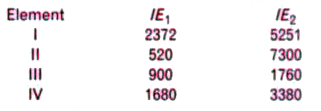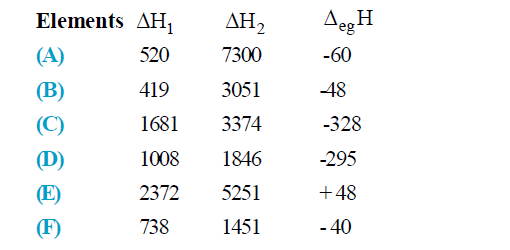The first (IE1) and second (IE2) ionisation energies (kJmol−1) of a new elements designated by roman numerals are shown below:
IE1IE2I23705250II5207300III9001800IV17003400
Which of the above elements is likely to be :
a. A reactive metal
b. A reactive non-metal
c. a noble gas
d. A metal that forms a stable binary halide of the formula AX2 (X= the halogen).
The correct Answer is:B
To solve the problem, we need to analyze the given ionization energies (IE) for the four elements and determine which element corresponds to each of the categories: reactive metal, reactive non-metal, noble gas, and a metal that forms a stable binary halide of the formula AX₂.
1. Understanding Ionization Energies:
- Ionization energy is the energy required to remove an electron from an atom. The first ionization energy (IE₁) is the energy needed to remove the first electron, and the second ionization energy (IE₂) is for removing the second electron.
- A large jump in ionization energy between IE₁ and IE₂ indicates that after the removal of the first electron, the atom achieves a stable electron configuration (like that of a noble gas).
2. Analyzing Each Element:
- Element I: IE₁ = 2370 kJ/mol, IE₂ = 5250 kJ/mol
- There is a significant increase from IE₁ to IE₂, indicating that after losing the first electron, the atom reaches a stable configuration. This suggests it is a reactive metal (likely from Group 1).
- Element II: IE₁ = 520 kJ/mol, IE₂ = 7300 kJ/mol
- There is a very large jump in ionization energy, suggesting that this element is a non-metal, likely a halogen, as it requires a lot of energy to remove the second electron after achieving a stable configuration.
- Element III: IE₁ = 900 kJ/mol, IE₂ = 1800 kJ/mol
- The increase from IE₁ to IE₂ is moderate, indicating that this element is likely a metal that can lose two electrons but does not have a drastic jump, suggesting it may form stable compounds.
- Element IV: IE₁ = 1700 kJ/mol, IE₂ = 3400 kJ/mol
- Similar to Element III, the increase is moderate, but both values are relatively high, indicating this could also be a noble gas.
3. Matching Elements to Categories:
- a. Reactive Metal: Element I (2370, 5250)
- b. Reactive Non-Metal: Element II (520, 7300)
- c. Noble Gas: Element IV (1700, 3400)
- d. Metal that forms stable binary halide AX₂: Element III (900, 1800)
Final Answers:
- a. Element I is a reactive metal.
- b. Element II is a reactive non-metal.
- c. Element IV is a noble gas.
- d. Element III is a metal that forms a stable binary halide of the formula AX₂.
- Ionization energy is the energy required to remove an electron from an atom. The first ionization energy (IE₁) is the energy needed to remove the first electron, and the second ionization energy (IE₂) is for removing the second electron.
- A large jump in ionization energy between IE₁ and IE₂ indicates that after the removal of the first electron, the atom achieves a stable electron configuration (like that of a noble gas).
- Element I: IE₁ = 2370 kJ/mol, IE₂ = 5250 kJ/mol
- There is a significant increase from IE₁ to IE₂, indicating that after losing the first electron, the atom reaches a stable configuration. This suggests it is a reactive metal (likely from Group 1).
- Element II: IE₁ = 520 kJ/mol, IE₂ = 7300 kJ/mol
- There is a very large jump in ionization energy, suggesting that this element is a non-metal, likely a halogen, as it requires a lot of energy to remove the second electron after achieving a stable configuration.
- Element III: IE₁ = 900 kJ/mol, IE₂ = 1800 kJ/mol
- The increase from IE₁ to IE₂ is moderate, indicating that this element is likely a metal that can lose two electrons but does not have a drastic jump, suggesting it may form stable compounds.
- Element IV: IE₁ = 1700 kJ/mol, IE₂ = 3400 kJ/mol
- Similar to Element III, the increase is moderate, but both values are relatively high, indicating this could also be a noble gas.
- a. Reactive Metal: Element I (2370, 5250)
- b. Reactive Non-Metal: Element II (520, 7300)
- c. Noble Gas: Element IV (1700, 3400)
- d. Metal that forms stable binary halide AX₂: Element III (900, 1800)
- a. Element I is a reactive metal.
- b. Element II is a reactive non-metal.
- c. Element IV is a noble gas.
- d. Element III is a metal that forms a stable binary halide of the formula AX₂.
Topper's Solved these Questions
- CLASSIFICATION OF ELEMENTS AND PERIODICITY BOOK - NCERT FINGERTPS ENGLISHCHAPTER - CLASSIFICATION OF ELEMENTS AND PERIODICITY EXERCISE - EXEMPLAR PROBLEMS
12 Videos
- CLASSIFICATION OF ELEMENTS AND PERIODICITY BOOK - NCERT FINGERTPS ENGLISHCHAPTER - CLASSIFICATION OF ELEMENTS AND PERIODICITY EXERCISE - ASSERTION & REASON
15 Videos
- CLASSIFICATION OF ELEMENTS AND PERIODICITY BOOK - NCERT FINGERTPS ENGLISHCHAPTER - CLASSIFICATION OF ELEMENTS AND PERIODICITY EXERCISE - Assertion And Reason
15 Videos
- CHEMICAL BONDING & MOLECULAR STRUCTUREBOOK - NCERT FINGERTPS ENGLISHCHAPTER - CHEMICAL BONDING & MOLECULAR STRUCTUREEXERCISE - Assertion And Reason
15 Videos
- ENVIRONMENTAL CHEMISTRYBOOK - NCERT FINGERTPS ENGLISHCHAPTER - ENVIRONMENTAL CHEMISTRYEXERCISE - Assertion And Reason
15 Videos
Similar Questions
The first (IE1) and second (E2) ionization energies (kJ/mol) of few elements designated by Roman numerals are given below. Which of these would be an alkali metal?
View SolutionThe (IE1) and the (IE2) in kJmol−1 of a few eiements designated by Roman numberals are shown below.
∣∣ ∣∣IIIIIIIE14035491142IE2264010602080∣∣ ∣∣
Which of the above elements is likely to be a
(a) non-metal (b) alkali metal (c ) alkaline earth metal?
View Solution
Knowledge Check
The first (ΔiH1 and second (ΔiH2 ionization enthalpies (in kJ/mol) and electron gain enthalpy (in kJ/mol) of few elements are given below:
ElementsΔiH1ΔiH2ΔegHI5207300−60II16813374−328III8991757−48IV23725251+48
Which of the following is likely to be an alkali metal?AI and IVBV and IICII and VDIV and V
The first (IE1) and the second (IE2) ionisation energies (kJ mol−1) of a few elements are given below :

Which of the above elements is likely to be
a noble gas?
View SolutionThe first (IE1) and the second (IE2) ionisation energies (kJ mol−1) of a few elements are given below :

Which of the above elements is likely to be
a reactive metal?
View SolutionThe first (IE1) and the second (IE2) ionisation energies (kJ mol−1) of a few elements are given below :

Which of the above elements is likely to be
a reactive non-metal?
View SolutionThe first (ΔiH1) and second (ΔiH2) ionisation enthalpies (inkJmol−1) and the (ΔegHө) electron gain enthalpy (inkJmol−1) of a few elements are given below:
Elements(ΔiH1)(ΔiH2)ΔegHөI5207300−60II4193051−48III16813374−328IV10081846−295V23725251+48VI7381451−40
Which of the above elements is likely to be
a. the least reactive element.
b. the most reactive metal.
c. the most reactive non-metal.
d. the least reactive non-metal.
e. the metal which can form a stable binary halide of the formula MX2 (X=halogen).
f. the metal which can form a predominantly stable covalent halide of the formula MX(X=halogen).
View SolutionThe first and second ionization enthalpies and electron gain enthalpy of some elements are as given below:

A metal which can form a stable binary halide of the type MX2 is (X : Halogen)
View SolutionThere are three elements I, II, III and their ionisation energies are given below.
IE1IE2I23725251II9001760III5207300
Now identify
(a) Which element is most reactive ?
(b) Which element is noble gas ?
(c ) Which can form a stable dihalide ?
View SolutionFirst three ionisation energies (in kJ/mol) of three representative elements are given below:
(Element,IE1,IE2,IE3),(P,495.8,4582,6910),(Q,737.7,1451,7733),(R,577.5,1817.2745)
then incorrect option is:
View Solution
